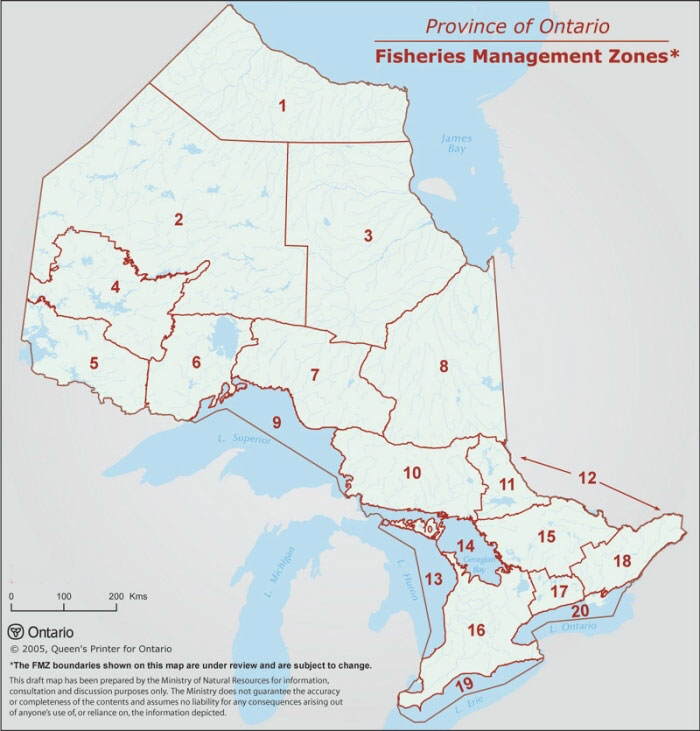Fisheries management zones
How fisheries management zones (FMZs) monitor and manage Ontario’s recreational fisheries.
About FMZs
Ontario is broken down into 20 fisheries management zones (FMZs). FMZs help the province manage the individual needs and nature of each zone by customizing catch limits and seasons to:
- allow more fishing in thriving fisheries
- protect vulnerable fisheries
- re-establish fish populations
- adjust fishing seasons for different climates
Each zone has its own rules that you must follow. Maps of the fisheries management zones and the fishing regulations are available in the:
Ontario Fishing Regulations Summary
Provincially significant inland fisheries
Some zones contain important lakes and rivers that need more careful management, planning and monitoring. For example:
- Lake Nipissing
- Lake Simcoe
These important fisheries, called “provincially significant inland fisheries” are managed differently than the rest of their FMZ.
FMZ planning
Fisheries management follows a cycle of:
- planning (setting objectives and strategies)
- implementing strategies
- monitoring and reporting
- evaluating success
FMZ advisory councils
The ministry wants the public to get involved in the FMZ planning process. The ministry is setting up advisory councils in each FMZ to hear from:
- angling groups
- scientists and researchers
- conservation groups
- interested community members
FMZ advisory councils will:
- share their ideas and expertise with the ministry
- help to develop and implement management strategies
- communicate with the local and angling communities
FMZ advisory councils in place
Currently, there are councils for:
- Northwest Ontario – FMZs 4, 5, and 6
- Northeast Ontario – FMZs 10, 11, and 12
- Great Lakes – FMZs 9, 13, 14, 19, 20
- Southern Ontario – FMZs 12, 15, 17, 18
Learn about your FMZ
Each fisheries management zone reports on its activities:
- calls for consultation
- monitoring and management reports
- advisory council news
- changes to fishing regulations
- fish stocking
Find your zone based on where you plan to fish.

Northwest Ontario
- FMZ 1, 2, 3 (Far North)
- FMZ 4 (Kenora, Red Lake, Dryden, Sioux Lookout, Thunder Bay)
- FMZ 5 (Fort Frances, Kenora and Dryden)
- FMZ 6 (Thunder Bay, Nipigon, Dryden)
- FMZ 7 (Geraldton, Terrace Bay, Manitouwadge, Wawa)
Northeast Ontario
- FMZ 1, 2, 3 (Far North)
- FMZ 7 (Geraldton, Terrace Bay, Manitouwadge, Wawa)
- FMZ 8 (Hearst, Chapleau, Cochrane, Timmins, Kirkland Lake)
- FMZ 10 (Sault St. Marie and Sudbury)
- FMZ 11 (North Bay and Nipissing)
- FMZ 12 (Ottawa River)
Great Lakes
- FMZ 9 (Lake Superior)
- FMZ 13 (main basin of Lake Huron)
- FMZ 14 (Georgian Bay and the North Channel of Lake Huron)
- FMZ 19 (Lake Erie)
- FMZ 20 (Lake Ontario)
Southern Ontario
- FMZ 12 (Ottawa River)
- FMZ 15 (Parry Sound, Bancroft, Pembroke, Algonquin Park)
- FMZ 16 (South-Western Ontario and Lake Simcoe)
- FMZ 17 (Peterborough and the Kawartha Lakes)
- FMZ 18 (Eastern Ontario)
Monitoring
Monitoring and management go hand in hand. Monitoring helps fisheries management teams, locally and provincially, to:
- make informed decisions
- report on the state of the fisheries
- measure progress toward planning goals
For example, monitoring is used to:
- estimate the current status, trends and changes in fish and their habitat
- describe the geographic distribution, extent and diversity of aquatic ecosystems
- identify the connections between natural and manmade stresses and the condition of a lake or fish population
Monitoring methods
There are two main types of monitoring:
- broad-scale monitoring
- intensive monitoring
Broad-scale monitoring
Broad-scale monitoring collects a small amount of information on a large number of lakes. This type of monitoring provides big-picture surveys used to:
- report on the condition of fisheries
- make management decisions
Broad-scale monitoring collects information on certain lakes in each FMZ every 5 years:
- sport fish populations
- fish communities
- aquatic habitat
- fishing effort
Monitoring the health of Ontario inland lakes
Intensive monitoring
Intensive monitoring collects a lot of information on a smaller number of lakes. Fisheries managers use intensive monitoring to:
- investigate lakes in greater detail and over the long term
- support and interpret the results of broad-scale monitoring
- to monitor large lakes with intensive fishing pressure
Monitoring reports
The ministry often posts new monitoring reports on its fisheries management zone pages to:
- help the public take part in resource management and decision-making
- share the results of fisheries management decisions